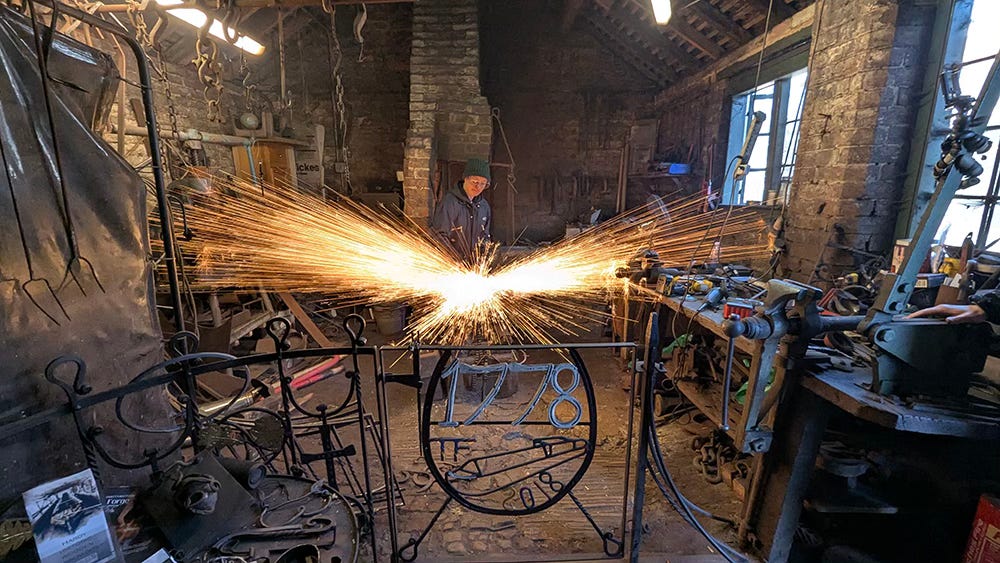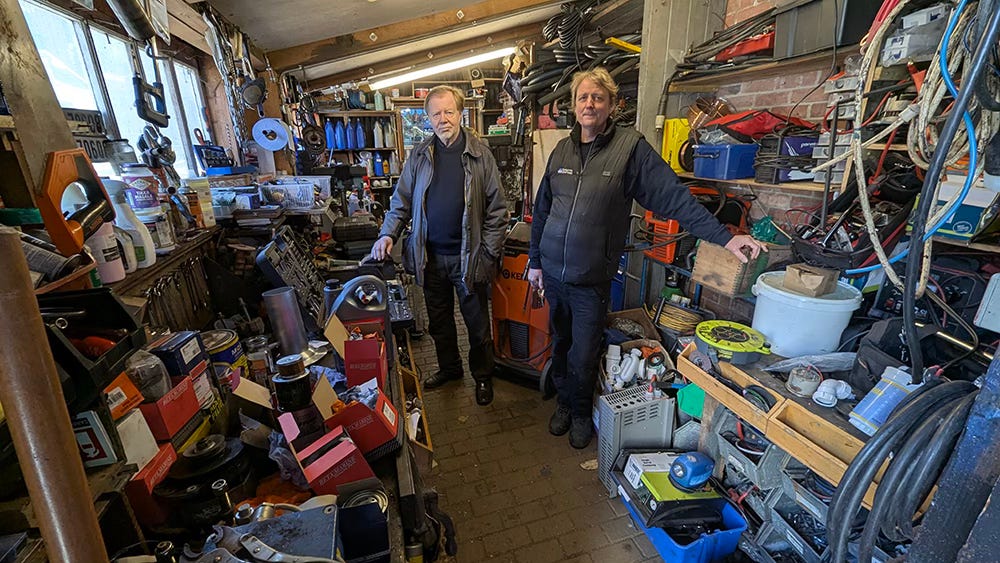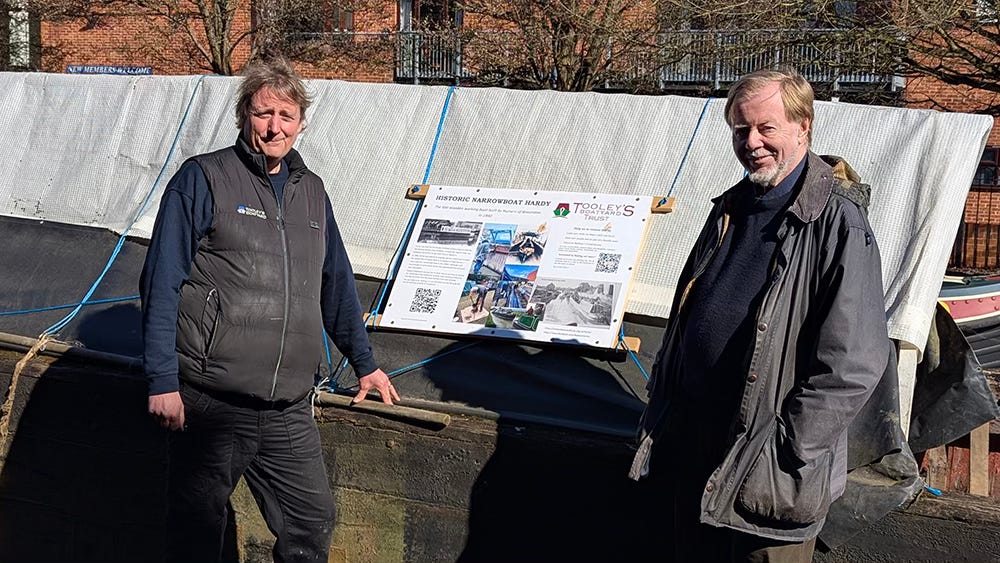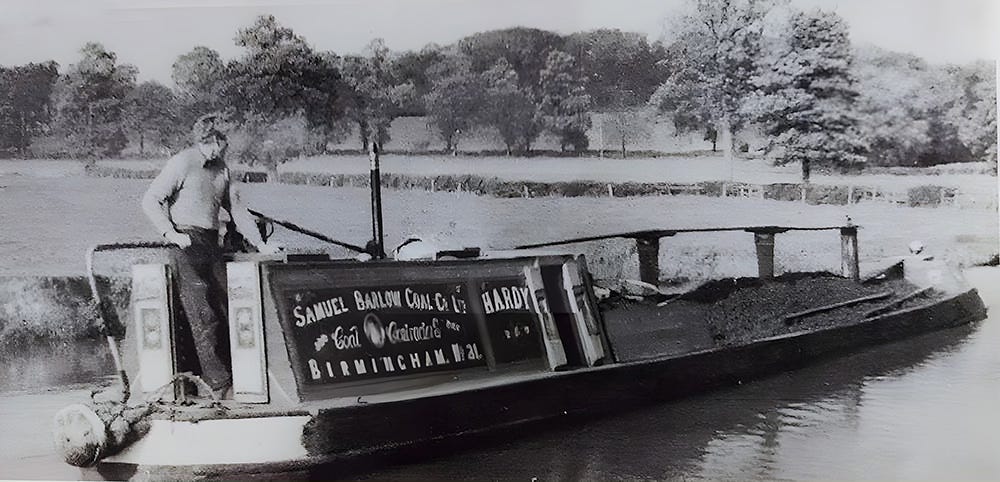A future for Tooley's
On his way down the Oxford Canal this spring, Andrew Denny was delighted with what he found at Banbury
It always surprises me how revisiting canal locations allows me to see places anew. This spring, travelling down the south Oxford Canal for the first time in 15 years, I stopped for a week at Banbury. I thought I was already familiar with the canal legend of Tooley’s dry dock, having briefly visited it at the town’s annual Canal Day, but exploring it again last month made me see it in a new light.
Banbury’s canalside has seen continued development, and the historic little boatyard is now dwarfed more than ever. But that only seems to add to its charm.
A living museum
These days Tooley’s Boatyard is increasingly seen as ‘ground zero’ of the waterways restoration movement. To this scruffy little boatyard in 1939 L.T.C. Rolt brought his new wife and old Shropshire fly conversion Cressy, and in a matter of weeks they together spent time converting it to their “design for life”.

Is it overblown to argue that Britain’s waterways revival was sparked here, among the collection of tumbledown buildings that improbably survive alongside the modern shopping centre? Unlike almost every other canal boatyard, Tooley’s has been in near-continuous operation since the canal opened here in Banbury in July 1778.
“The contrast here between old and new is stark,” says boatyard operator Matt Armitage, in the introduction to his book Forging Ahead (Windlass Publishing, £11.99), which tells the story of the yard. It’s an excellent potted history of the business.
The dry dock – the focus of the whole place, at least from the canal and towpath – now has a modern, garish sawtooth roof. The architects who designed the shopping centre 25 years ago probably thought it was a good idea at the time.
But it wasn’t until I had the chance to explore the whole cluster of buildings, most hidden away, that I understood its appeal. Tooley’s is a labyrinth of six or seven workshops that are slowly being restored, and it is a true living museum.
The dry dock is as busy as ever – 100 boats a year still pass through it – and there’s the carpenter’s shop, the paint shop and the belt room. The latter houses the old collection of belt drive machines, long outdated (and outlawed by the Health and Safety Act 1974), but kept working at one-tenth speed to demonstrate how they operated.
For me, the real star is the blacksmith’s forge building. Contrasted with the clinical supermarket-vernacular architecture of the shopping centre, it’s a higgledy-piggledy building that reminds me of the Weasley house in Harry Potter. The magic continues inside when there’s a smith at work – the sparks literally do fly!
For casual visitors, entry to most of the site is free, although you might have to ask to see some rooms, and there are safety aspects to consider, not least those spectacular flying sparks. Stand well back!
Survival of the quirkiest
We all call it Tooley’s Boatyard of course, but that’s just because Tom Rolt did, in Narrow Boat. It never really had a name, unless it was simply ‘Banbury boatyard’.
The current title came after most of the site (except the forge) burned down in 1897. Local boatman George Tooley Snr took a lease soon after, by which time the premises consisted, along with the forge, of the dry dock, a stable, boiler and steam chest (used for bending planks for boat-building).
“George Tooley Senior, born 1869, was the epitome of the self-made businessman,” writes Matt Armitage in Forging Ahead. “He was often seen working with his shirt sleeves rolled up, a waistcoat and the essential status symbol of a bowler hat. He had two sons, George Jnr born in 1903, and Herbert born in 1913, and he ensured the future of the yard by teaching them all the necessary skills.
“Crucial to their success was their sustained boating trade on the canal. Although they had the dock, they continued to take loads to and from [local business] Samuelson’s by employing boatmen to do it for them. In this way, they understood their customers’ needs, helping to build and establish trust within the boating community.
Tooley brothers
Herbert and George Jnr worked at the boatyard from the 1920s, under the close supervision of their father, developing the skills necessary to repair and maintain boats.
When they were old enough, they would help out at the boatyard after school and at weekends. By 1939, they were renowned for their expertise and artistry, which is why Tom Rolt chose to have Cressy fitted out at the yard.
Lean years
George Snr died in 1940, and the war and the decline in the canals hit the Tooleys hard. But despite the reduced demand, George Jnr and Herbert somehow managed to survive through the lean years right up until the 1980s. But by the 1960s the town was undergoing regeneration and the family home nearby was compulsorily purchased and demolished. Herbert was to live in a caravan on the site for the rest of his life, until he died in 1987, aged 73.
But by then the two surviving Tooleys had found allies in the waterways restoration movement. A plan in the early 1970s to demolish the yard and build a marina on the site was thrown out by the council. Local IWA members urged Cherwell District Council to seek preservation orders. As a result, in 1975, the site was scheduled as an industrial monument.
Interviewing Herbert in 1982 for Waterways World magazine, Ian Mackersey wrote: “The Banbury boatyard is destined one day to become, no doubt, a waterways shrine; perhaps even a museum preserving for future generations the authentic structures and equipment which supported a style of craftmanship which will not for much longer be practised.”
But that was a horror to Herbert: “I don’t want it to become a museum! I’d like to see somebody keep it on as a [working] dock. Wooden boats or steel, what does it matter?”
The future of the yard was far from certain, following Herbert’s passing. British Waterways agreed to let another local boatyard operator, Pete Downer, use the site on a temporary basis until 1988, following a meeting with George Tooley.
In October 1993 George Tooley died at the age of 88 following a short illness. Neither he nor Herbert, sadly, had family to continue. This closed the final chapter of almost a century of association with the yard. Yet the family’s legacy continues to this day, and while the yard is operated by different owners, it will always simply be known as ‘Tooley’s’.
After Herbert’s death, Barrie Morse took over the dock between 1990 and 1998. As well as continuing dry-dock work he built several boats there. These included a narrowboat for Timothy West and Prunella Scales, which they moored nearby for several years.
In 1998 the yard closed temporarily as work began on the Castle Quay shopping centre surrounding it. Nevertheless, its historical and cultural importance was recognised by Birmingham University, whose industrial archaeology department drew, photographed and meticulously recorded everything. Artefacts were removed for examination and safe keeping during the building work, and replaced in their original positions once the development opened.
The university reported, “In several important ways the development of the boatyard was also a reflection of the unique culture of the boat people, and specifically of the character of the Tooley family. Here, concepts such as craftsmanship, versatility and a devotion to the recycling of any materials were crucial, notions that Tom Rolt highlighted in his book Narrow Boat.”
The present
The new lease in Tooley’s life began with Matt Armitage. An archaeologist by training and historian by inclination, he somehow ended up running restaurant-boat Rosamund the Fair in Oxford. Loving the waterway life, he looked for boatyard training and was surprised to find there was no specialist apprenticeship for narrowboat engineering. He ended up taking conventional motor trade courses, before operating the well-known Jericho boatyard in Oxford.
When Matt learned the Jericho boatyard had been closed and sold from underneath him, but Tooley’s was now ready to reopen, the historian and archaeologist inside him seized the chance to take the lease on the newly reopened Banbury boatyard.
It’s not been easy. While the yard is a working and thriving business, the historic buildings and other structures continue to need more maintenance than most more modern premises, and new regulations make operating ever harder.
Remembering the insecurity he had over the Jericho boatyard, Matt has worked hard over the last two decades to protect the heritage in his care. Satisfaction came in 2019 with the creation of the Tooley’s Boatyard Trust and securing a 150-year lease from Cherwell District Council, with the help of John Madden, a local businessman, and eight other trustees.
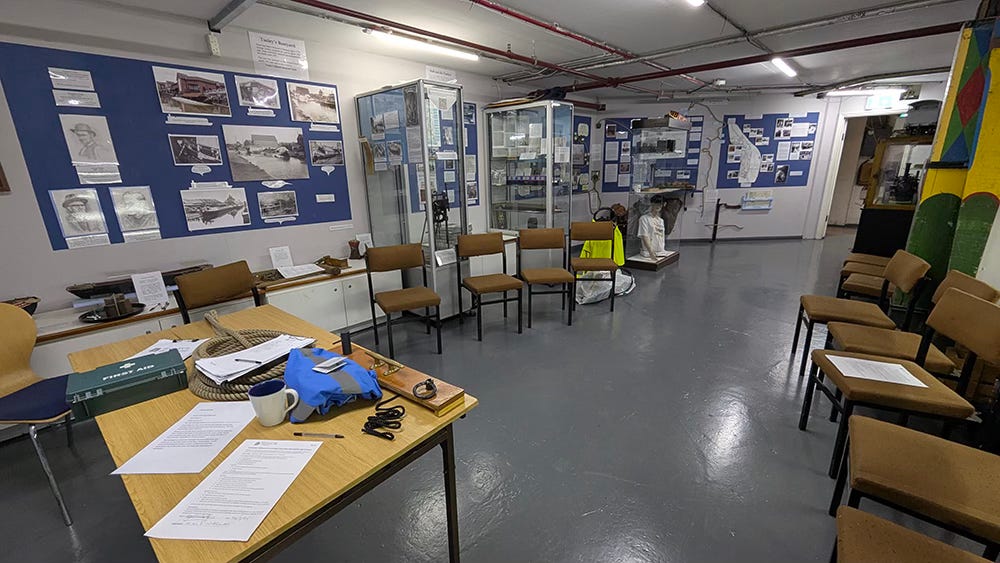
For canal enthusiasts, perhaps the most fascinating element of the whole Tooley’s experience is the museum room in the old carpentry workshops. It includes many items that would impress the National Waterways Museum, such as personal memorabilia from the original Cressy, on loan from the Rolt family. These include waterways art objects painted by the brothers. (Herbert also painted the cover for the first edition of Narrow Boat.)
Training and restoration
Tooley’s Boatyard Trust aims to advance public education by establishing the site as a working heritage centre focused on narrowboat maintenance and construction.
By 2007 the new Tooley’s had completed construction of its first steel boat, Dancing Duck. Nominally a trip-boat, it serves not only as an income stream for the boatyard, but also as a general workboat for the area, often towing other boats.
Matt, remembering his own difficulty in getting specialist boatyard training when starting out – and indeed of finding ready-trained new staff – aims to ensure there is at least one ‘flagship’ historic boat the yard can always find to work on.
So it was that in 2018 he learned of Hardy, a wooden boat built by Nurser of Braunston in 1940, which was slowly mouldering in a muddy grave on the Oxford Canal’s Braunston Puddlebanks and in danger of disintegration. Although not originally built by Tooley’s, it had spent much of its life carrying coal on the Oxford Canal, and thus had a heritage to fit. Taking Dancing Duck as a towing boat, he and his team raised Hardy and brought it back to Banbury, where it is now slowly being restored.
Recently, National Historic Ships made a grant to the Tooley’s Trust towards the next stage of its restoration, and you can see the work being carried out on the boatyard’s website. Matt outlined his training and apprenticeship ideas in WW in September 2022 (‘Boat Skills Shortage'). He continues to seek industry and government support for the concept.
As head of the ten trustees, John Madden now oversees the future of the site, while Matt has time to focus more on the yard as a hard-nosed business.
Future plans include re-roofing the dry dock with a training room above (the present roof, a legacy of the building of Castle Quay in 1999, is already leaking), outfitting the museum room, and constructing a special glass-screened viewing area inside the dry dock so that visitors can see maintenance close-up in safety.
Tooley’s now has perhaps the best of both – no, three – worlds. It’s a busy working boatyard, yes, and duly honours the wishes of Herbert Tooley. But it is also a museum, and a focus of inland waterways training, particularly for traditional boatyard skills.
An echo of this still survives in the forge, which operates separate smithy training, demonstrating many techniques beyond boatyard skills.






